Stonehenge Construction Periods, Phases, and History
Stonehenge is definitely one of England's greatest icons. Its original purpose is still somewhat unclear, but some have speculated that it was a temple made for worship of ancient earth deities. It has also been called an astronomical observatory for marking significant events on the ancient prehistoric calendar. Others claim that it was a sacred site created by Merlin and King Arthur for the burial of high-ranking citizens from societies of long ago.
No matter what the claim has been for Stonehenge's original purpose, the truth is that it has inspired countless generations of people to strive to learn and figure out the history of our past. Stonehenge is somewhat a "gateway to the realms" providing insights into humanities past and showing that maybe we were not as "technically challenged" as some would like us to believe.
Construction of Stonehenge was broken into three periods:
Stonehenge Period I (c. 2950-2900 BC)
The earliest portion of Stonehenge dates to approximately 2950-2900 BC. The dates for each "period" can be fixed to about a 100 years or so with radiocarbon dating, but as to the exact building sequence within each period archaeologist cannot be certain.
The first period of Stonehenge was basically a circular enclosure outlined by two banks and a ditch with an entrance to the northeast and a standing stone a bit away from the entrance.
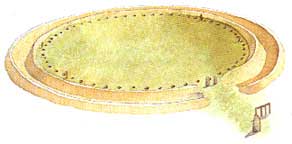
|
|
Stonehenge Period I (image from Mohen) |
The outer circle was made from earthand even though it is now mostly destroyed, it was about 380 feet in diameter, 8 feet wide, and 2 or 3 feet high.
The ditch (more like pits) was not uniform in shape or depth and it varied in width from 10 - 20 feet and a depth of 4.5 - 7 feet. Not much effort was taken in keeping the ditch clean. Archaeologists have been able to use the varied fragments (picks made of red deer antlers, scoops made of oxen shoulder blades, and some pottery fragments) found near the bottom of the ditch to help date its construction.
Next was the chalkwork inner bank of Stonehenge. It was an impressive sight standing at least 6 feet high, about 20 feet wide and had a diameter of 320 feet. It was composed of the solid chalk that makes up most of the surface region around Stonehenge. An interesting fact to note is that all of the other Stonehenge type monuments have their bigger encircling banks outside of the quarry ditches; yet Stonehenge has its bigger bank within the ditch. No one has been able to figure out why Stonehenge was done like this.
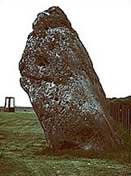
|
| The Heel Stone. |
From the center of the circle facing northeast is the entrance into Stonehenge. It is about 35 feet wide and is set so that a person standing in the center of Stonehenge can see the sun rise on midsummer morning just to the left of the heel stone.
The naturally shaped heel stone is about 20 feet long and 8 feet wide by 7 feet thick. Its lower 4 feet is buried in the ground and it weighs an estimated 35 tons. It is made up of natural sandstone called sarsen which are thought to have come from Marlborough Downs, 20 miles to the north of Stonehenge. Currently the heel stone leans inward toward the circle at an angle of about 30 degrees from the perpendicular, but it is believed that the stone was once standing straight. Circling the stone about 12 feet from its base is a covered ditch filled with chalk.
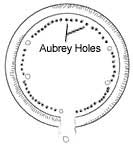
|
| Aubrey Holes. |
Inside the circle are 56 Aubrey holes (named after their 17th century discoverer John Aubrey) which vary from 2.5 - 6 feet in width, and 2 - 4 feet in depth. They were spaced quite accurately in a 288 foot diameter circle with an average center point for each hole of 19 inches (+/- an inch or two).
Probably also dating to this time are the four Station Stones (only two survive) which stand approximately on the circle of Aubrey holes. They formed a rectangle perpendicular to the midsummer sunrise line of the monument. Of the two still standing, one is naturally shaped while the other is slightly tooled. There is some contention among archaeologists as to when the Station Stones were placed at Stonehenge but general consensus is during period I.
Stonehenge Period II (c. 2900-2400 BC)
It is unclear how long the first period of Stonehenge was in use before being altered. Archaeologists are not sure what exactly was done during the second period but it is believed that the Beaker people were responsible for the second wave of building at Stonehenge. Some feel that bluestones from the Preseli Mountains in west Wales were brought in, while others are very intrigued by the post-holes found scattered about the monument. Even though the post-holes appear to be spaced randomly, there are some clusters and patterns that do show up. By no means are these clusters like those of nearby Woodhenge, but they do make us think twice about what might have been happening at Stonehenge during the second period.
If you decide to follow this belief that the post-holes were used to create a structure, the easiest clusters to note are the ones in the northeastern entrance. They form a series of holes that could of been used to create wooden walls that maybe made a narrow triple entrance into Stonehenge. Recently archaeologist have identified the remains of a palisade that ran to the west and north of Stonehenge. Palisade fences have been found in other places of a similar Late Neolithic date. It is possible that the palisade was used to form a sacred space since it did not enclose Stonehenge but instead just created a wall blocking it from view.
Cremation burials have been found cut into the infilled ditch and in the monument's interior (Aubrey Holes). Imagine the honor of being placed in such a sacred structure to rest at peace for all time. A majority of the cremations were determined to be from the Late Neolithic/Early Bronze Age due to radiocarbon dating of the bone skewer pins used to hold the bags, in which the ashes were placed, closed.
Lastly, Stonehenge's old ditch bank entrance was widened another 25 feet and a 40 foot wide "Avenue" lined by parallel banks and ditches 47 feet apart extended out from it. Even though it is hard to see now, the Avenue originally went northeast from Stonehenge and slowly curved right for 2 miles to the river Avon.
Stonehenge Period III (c. 2550-1600 BC)
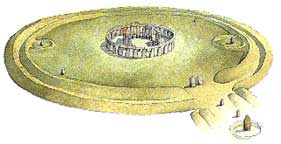
|
|
Stonehenge Period III (image from Mohen) |
Stonehenge's third period was the longest and contained the most changes of all the periods. The original three subphase scheme of period three was drawn up by Professor Richard Atkinson who was the leading investigator of Stonehenge in the 1950s and 1960s. Archaeologists do not fully agree on how many different "subphases" there were during this period and recently they feel that there were no fewer than six. Unfortunately we may never know the exact amount of subphases, but certainly this period was the busiest of them all.
* Subphase A - period III
General consensus is the first erected stones were those of the bluestones. They were set up in two concentric circles made of at least 82 bluestone Menhirs (large, rough-hewn standing stones). These stones weighed about 5 tons each and were 6 feet apart - 35 feet from the center. Supposedly the bluestone came from the Preseli Mountains in southwestern Wales. It is also felt that the Altar Stone was placed during this subphase.
* Subphase B - period III
About 100 years later the bluestones were dismantled and the Stonehenge as we see it today started to show.
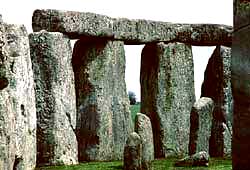
|
| Sarsens and Lintels |
A 100 foot diameter circle of 30 sarsen-stone (weighing up to 50 tons each) uprights capped by a continuous ring of sarsen lintels was erected in the center of the site. Sarsen is a very hard form of sandstone found particularly on the Marlborough Downs some 18 miles to the north. This circle surrounded a horseshoe-shaped setting of five sarsen trilithons (formations in which two uprights support a lintel) with its opening pointing to the northeast side. No other megalithic structure in northwestern Europe displays the precision and architectural refinement that Stonehenge does.
* Subphase C & D - period III
Some of the bluestones were shaped, dressed, and then reerected in an oval structure within the center of the sarsen horseshoe. It is also believed that if the Altar Stone was not placed in subphase A, then it was probably installed in its present position at this time. An additional circle of bluestones were set up within the outer sarsen circle.
Subphase E - period III
Right around 1900 or 1800 BC Stonehenge was almost complete as we see it today. The now-fallen Alter Stone was the focal point of two circles of sarsen and bluestones and two horseshoes of sarsen and bluestones. It is believed the inner bluestone oval was rearranged to form the second smaller horseshoe within the great trilithons.
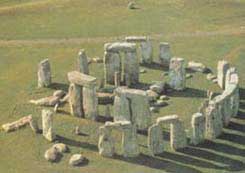
|
| Completed Stonehenge |
* Subphase F - period III
The completing phase was two concentric rings of pits about 20 feet apart and dug around the outside of the stones. Lt-Col Hawley discovered them in 1923 and called them Y and Z Holes (he considered the Aubrey Holes to be the X holes). It is possible that these holes were dug to take yet another setting of stones but for whatever reason this phase was never carried out. Gerald Hawkins raises a wonderful idea that these holes were used to make Stonehenge a calendar for astronomical events. See his book Stonehenge Decoded for more information.
